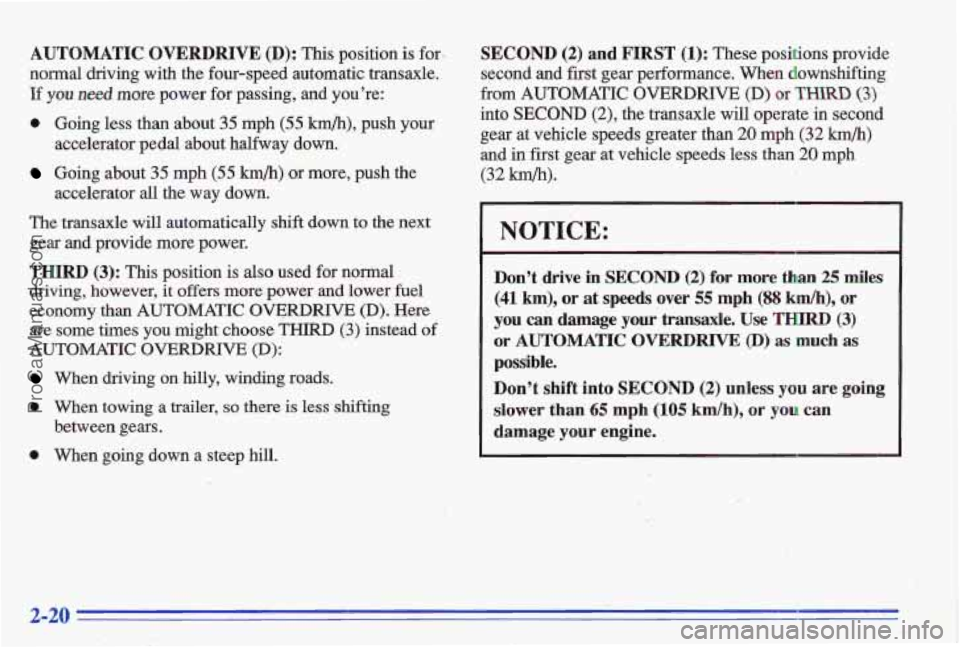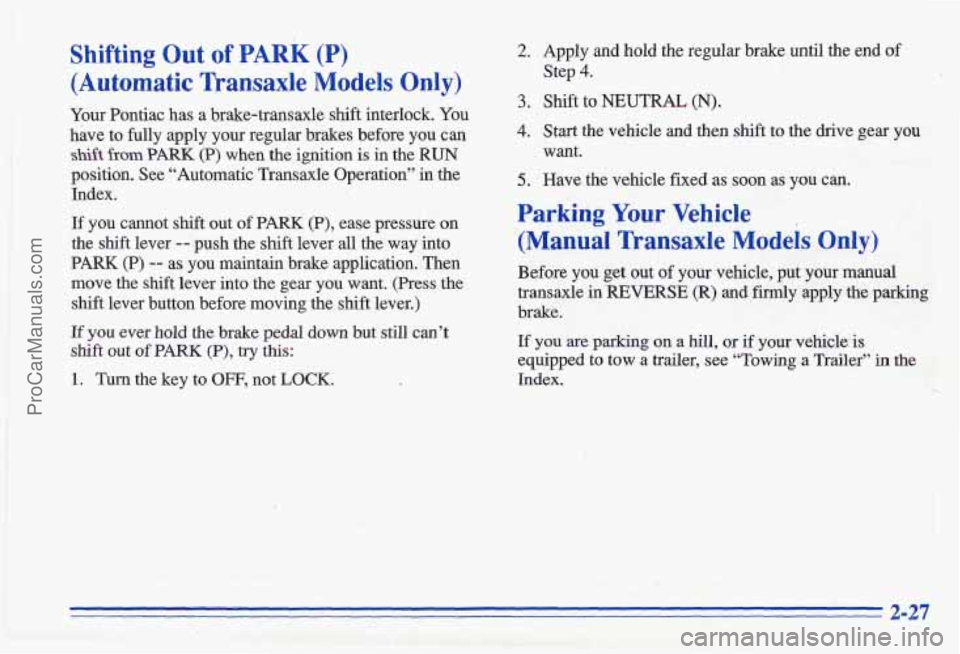Page 76 of 356

AUTOMATIC OVERDRIVE (D): This position is for-
normal driving with the four-speed automatic transaxle.
If
you need more power for passing, and you’re:
0 Going less than about 35 mph (55 km/h), push your
Going about 35 mph (55 km/h) or more, push the
The transaxle will automatically shift down to the next gear
and provide more power.
THIRD (3): This position is also used for normal
driving, however, it offers more power and lower fuel
economy than AUTOMATIC OVERDRIVE (D). Here
are some times you might choose THIRD (3) instead of
AUTOMATIC OVERDRIVE (D):
When driving on hilly, winding roads.
0 When towing a trailer, so there is less shifting
0 When going down a steep hill,
accelerator
pedal about halfway down.
accelerator
all the way down.
between
gears.
SECOND (2) and FIRST (1): These positions provide
second and first gear performance. When downshifting
from AUTOMATIC OVERDRIVE (D) or THIRD (3)
into SECOND (2), the transaxle will operate in second
gear at vehicle speeds greater than 20 mph (32 km/h)
and in first gear at vehicle speeds less than 20 mph
(32 km/h).
_. .
NOTICE:
Don’t drive in SECOND (2) for more than 25 miles
(41 km), or at speeds over 55 mph (88 kdh), or
you
can damage your transaxle. Use THIRD (3)
or AUTOMATIC OVERDRIVE (D) as much as
possible,
Don% shift into SECOND
(2) unless you are going
slower than 65 rnph (109 kmh), or you can
damage your engine.
...
.’. ’ ir ’
2-20
ProCarManuals.com
Page 80 of 356
Parkiaag.’Brake handle. If the ignition is on, the brake system warning
light will come on.
To release the parking brake hold the regular brake
pedal down. Pull
the parking brake lever up until you
can press the release button. Hold the release button in
as you move the brake lever all the way down.
Driving with the parking, brake on can cause
your rear brakes to overheat. You may have to
replace them, and you could also damage other
To set the parking brake hold the .regular brake pedal If you are towing a trailer and are parking on my hill,
see “Towing
a Trailer” in the Index. That section shows
down with Your ‘ght foot* On the parking brake what to do first to keep the bailer from moving.
2-24
ProCarManuals.com
Page 81 of 356
Shifting Into PARK (P)
(Automatic Transaxle Models Only)
It can be dangerous to get out of your vehicle if
the shift lever
is not fully in PARK (P) with the
parking brake firmly
set. Your vehicle can roll.
If you have left the engine running, the vehicle
can move suddenly.
You or others could be
injured.
To be sure your vehicle won’t move, even
when you’re on fairly level ground, use the steps
that
follow. If you’re pulling a trailer, see
YI‘owing
a Trailer” in the Index.
2. Hold the brake pedal down with your right foot and
set the parking brake.
2. Move the shift lever into PARK (P) position‘like
this:
Hold in the button on the lever.
0 Push the lever all the way toward the front of
your vehicle.
3. Move the ignition key to LOCK.
4. Remove the key and take it with you. If you can
leave your vehicle yith the ignition key in your
hand, your vehicle is in PARK (P)
2-25
ProCarManuals.com
Page 83 of 356

Shifting Out of PARK (P)
(Automatic Transaxle Models Only)
Your Pontiac has a brake-transaxle shift interlock. You
have to fully apply your regular brakes before you can
shift from PARK (P) when the ignition is in the RUN
position. See “Automatic-Transaxle Operation” in the
Index.
If you cannot shift out of
PARK (P), ease pressure wn
the shift lever -- push the shift lever all the way into
PARK (P)
-- as you maintain brake application. Then
move the shift lever into the gear you want. (Press the
shift lever button before moving the shift lever.)
If you ever hold the brake pedal down but still can’t
shift
out of PARK (P), try this:
1. Turn the key to OFF, not LOCK. , ,<. j:~+!-,. , , ‘(, . .I. ”
,..I_ . , , . P ., , :. a -9 -- ....,. 4 -’. .:‘.I..: .,:- ;.
i.. ’ .--4 ..
2.
3.
4.
5.
Apply and hold the regular brake until the end of
Step
4.
Shift to NEUTRAL (N).
Start the vehicle and then shift to the drive gear you
want.
Have the vehicle fixed
as soon as you can.
Parking Your Vehicle
(Manual Transaxle Models Only)
Before you get out of your vehicle, put your manual
transaxle in’REVERSE
(R) and firmly apply the-parking
brake.
If you are parking on a hill, or if your vehic1e.k
equipped to tow
a trailer, see “Towing a Trailer” in the
Index.
ProCarManuals.com
Page 85 of 356

Running Your Engine While You’re
Parked (Automatic Transaxle)
It’s better not to park with the engine running. But if you
ever have to, here are some things to know.
/$ CAUTION:
Idling the engine with the air system control off
could allow dangerous exhaust into your vehicle
(see the earlier Caution under “Engine
Exhaust”).
Also, idling in a closed-in place can let deadly
carbon monoxide
(CO) into your vehicle even if
the fan switch is at the highest setting. One place
this can happen
is a garage. Exhaust -- with
CO -- can come in easily. NEVER park in a
garage with the engine running.
Another closed-in place can be
a blizzard. (See
“Blizzard” in
the Index.)
1
It can be dangerous to get out of your vehicle if
the shift lever
is not fully in PARK (P) with the
parking brake firmly set. Your vehicle can roll.
Don’t leave your vehicle when the engine is
running unless you have to.
If you’ve left the
engine running, the vehicle can move suddenly.
You or others could be injured.
To be sure your
vehicle won’t move, even when you’re on fairly
level ground,
always set your parking brake and
move the shift lever to PARK (P).
Follow the proper steps to be sure your vehicle won’t
move. See “Shifting Into PARK (P)” in the Index.
If you are parking on a hill and if you’re pulling a
trailer? also see “Towing a Trailer” in the Index.
2-29
ProCarManuals.com
Page 88 of 356

Turn and Lane Change Signals
The turn signal has two upward (for right) and two
downward (for left) positions. These positions allow you
to signal a turn or a lane change.
To signal a %urn, move the lever all the way up or down.
When the
turn is finished, the lever will return
automatically.
Q
A green arrow on the
instrument panel
will flash
in the direction of the turn
or lane change.
To signal a lane change; just raise or lower the lever
until the mow starts to flash. Hold it there until you
complete your lane change. The lever will return by
itself when
you release it.
As you signal a turn or a lane change, if the arrows flash
at twice the normal rate, a signal bulb may be burned
out.
If a bulb is burned,out, replace it to help avoid an
accident. If the arrows don't go on at all when you
signal
a turn, check for burned-out bulbs and then check
the fuse (see
"Fuses and Circuit Breakers" in the Index).
Headlamp High/Low Beam
To change the headlamps
from low
bearn to high or
high to
low, pull the turn
signal lever all
the way
toward you. Then release it.
When the high beams are
on, this blue light on the
instrument panel also will
be on.
The headlamp highfiow beam indicator light may flash
if the Daytime Running Lights (Dm) system is
experiencing a problem or if a headlamp is
malfunctioning. ~
2-32
ProCarManuals.com
Page 90 of 356
Windshield Washer
To wash your windshield, pull the stalk with th'e
windshield washer symbol toward you until the washers
begin.
The wipers will resume the speed you were using
before. If you had no speed selected, the wipers will
stop.
In freezing weather, don't use your washer until
the windshield
is warmed. Otherwise the washer
fluid can
form ice on the windshield, blocking
2-34
ProCarManuals.com
Page 100 of 356
Mirrors
Inside Manual Day/Night Rearview Mirror
To reduce glare from headlamps behind you, move the
lever toward you to the night position.
Manual Remote ,Control Mirror
The outside rearview mirrors should be adjusted so you
can just see the side of your vehicle when you are sitting
in a comfortable ,driving position.
1
Adjust the driver side
outside
mirror with the
control lever
on the driver’s
door.
To adjust your passenger side mirror, sit in the driver’s
seat and have
a passenger adjust the mirror for you.
ProCarManuals.com